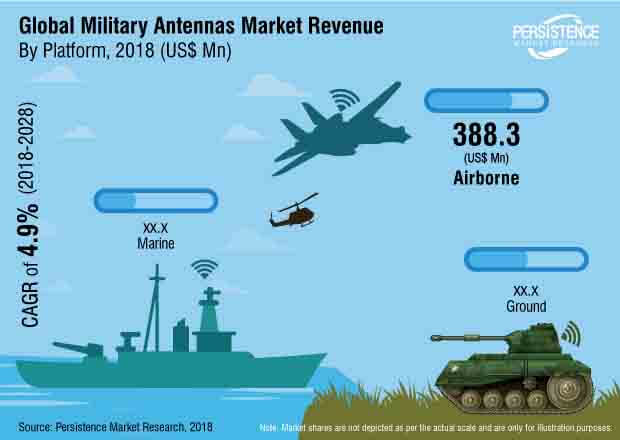Military Antenna Market Segmented By Airborne, Marine Ground Platform in Surveillance, Electronic Warfare, Navigation, Communication, Satcom, Telemetry with High Frequency, Very High Frequency, Ultra-High Frequency, Super High Frequency
Industry: Industrial Automation
Published Date: November-2018
Format: PPT*, PDF, EXCEL
Delivery Timelines: Contact Sales
Number of Pages: 206
Report ID: PMRREP13372
The report covers comprehensive information about market trends, volume (Units) and value (US$ Mn) projections, market dynamics, competition landscape and recent developments regarding the global military antennas market for the study period 2018 to 2028. The global military antennas market is expected to reach over US$ 1,593.4 Mn by the end of the forecast period, registering a CAGR of 4.9%. According to the analysis, the demand for military antennas is expected to grow and gain significant traction in the coming years. Increasing installation of military antennas in surveillance, electronic warfare, navigation, communication, Satcom and telemetry applications is expected to create healthy demand for military antennas in the future.
On the basis of platform, the global military antennas market has been segmented into ground, airborne and marine. Among the three, the ground segment is anticipated to dominate the global military antennas market with a gain of 170 BPS between 2018 and 2028, owing to the strong demand for military antennas in land applications.
As land force has full access to the air force and marine activities, it requires more antennas. The segment is estimated to be the most attractive among all its counterparts, and is expected to expand at a CAGR of 4.8% to reach US$ 522.4 Mn by the end of 2028.

Satellite communication plays a critical role in managing the integration of modern satellite communication into existing communications and reconnaissance architectures. As operational requirements have grown and technological innovations have progressed at a rapid pace, the bandwidth requirement has also grown exponentially.
As a result, C4ISR relies heavily on satellite communication to address the challenges faced by modern deployed forces. The development of satellite communication infrastructure has helped in providing new terrestrial communication networks to increase operational agility. Thus, the growth in satellite communication infrastructure will lead to rapid demand in the satellite and military antennas market.
The global defense market is closely associated with technology, particularly communication technology. Communication systems on the battlefield are vital components for mission success. With advancements in communication technology, one can share critical intelligence data as well as seamlessly transfer command and control instructions to gain a tactical advantage in the battlefield. However, with technological advancements in military communication systems, the cost of equipment is rising higher and higher. Technological development for military communication is greatly influenced by fully-interoperable solutions.
So, to gain an advantage from such solutions, a user has to pay high costs. Increased investments are likely to be made on amalgamating cutting-edge technologies with the express needs of the defense communication sector. Therefore, such equipment is expected to cost much more in the future, rendering it unaffordable for many nations. Hence, high cost is one of the major factors that may slow down the growth of the military communications market in the near future.
Rapid and extended economic growth in Asia and rise of sophisticated military technology are transforming the global defense landscape. Rapid developments in defense infrastructure across various countries of the region are creating huge demand for military-technical capabilities. Providers of military antennas can focus on expanding their businesses in countries of the region.
North America is projected to maintain its dominance in the global military antennas market throughout the forecast period. This can be attributed to the military expenditure, adoption of newer technologies and up gradation of existing systems and equipment by the U.S. army. The U.S. government spent more then 3.1% of its total GDP as military expenditure in 2017
The military antennas market is an entirely contract-based market. Manufacturers are forming contracts for specific periods of time with governments and private bodies for the supply of particular antennas. Moreover, they are also focusing on the establishment of long-term agreements with end users for the supply of military antennas.
In the recent past, the military antennas market has witnessed significant developments from a competitive perspective. Product innovations, mergers and acquisitions are some of the key preferred strategies opted by key players to sustain and enter in the global military antennas market.
Prominent players covered in the military antennas market include Harris, Cobham, Rohde & Schwarz, Mobile Mark, Inc., Antenna Products, MTI Wireless Edge, Hascall-Denke, Alaris Holdings Limited, AvL Technologies Inc., Comrod Communication AS, Eylex Pty Ltd, Antcom Corporation, Southwest Antennas and Amphenol Corporation, among others.
| Attribute | Details |
|---|---|
| Platform |
|
| Application |
|
| Frequency Band |
|
| Region |
|
To know more about delivery timeline for this report Contact Sales
